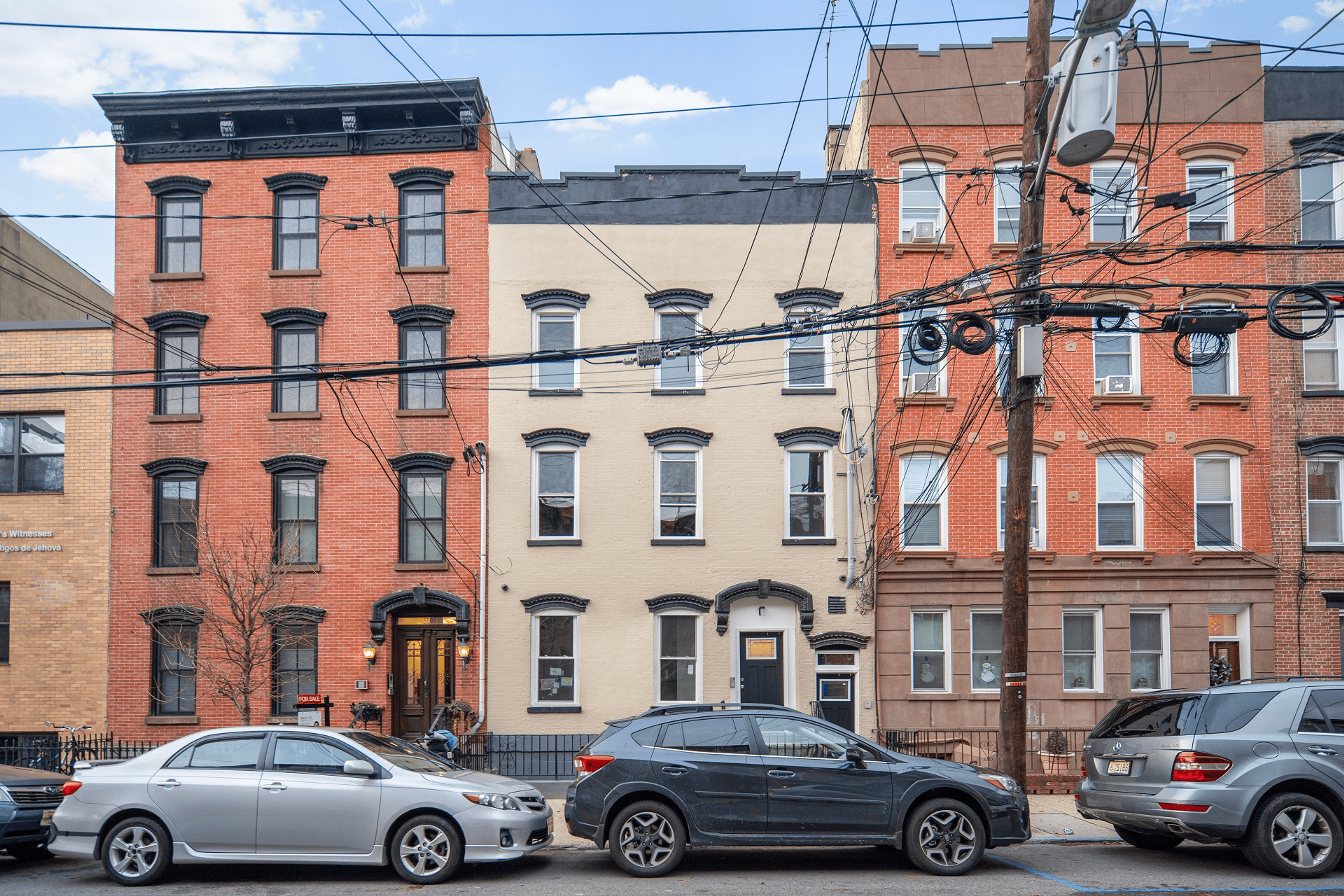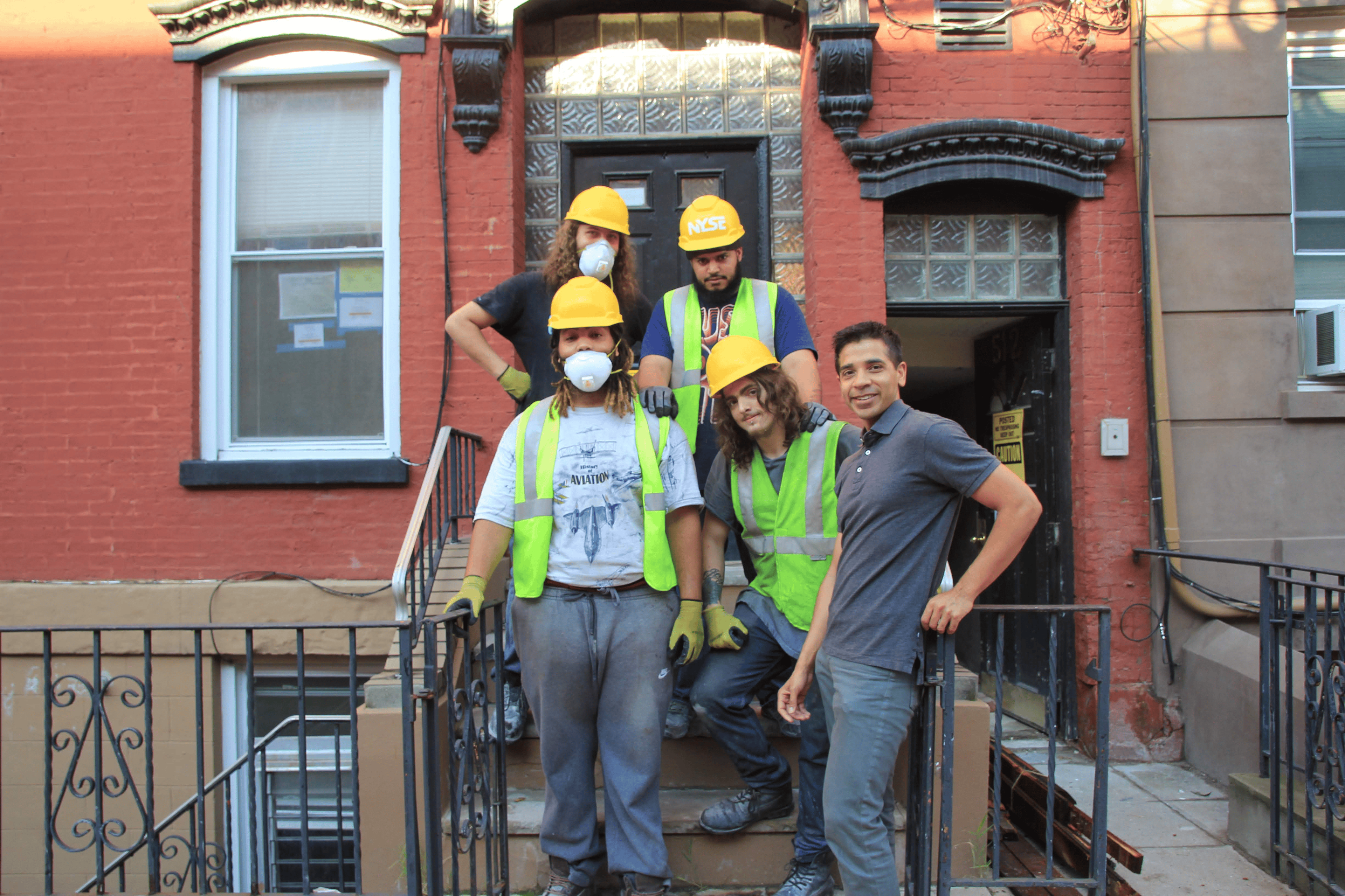
Atif Qadir
Amanat Properties
Atif Z. Qadir, a licensed architect turned developer, renovates historic buildings in New Jersey downtowns. As a founder of Amanat Properties and Commonplace, Hoboken City Planning Commissioner, and the host of the popular “American Building” podcast, he's on a mission to promote developers doing projects that are meaningful, impactful, and local.
We sat down with Atif to learn a few lessons from his development experience and understand how they shaped his personal mission.

RESTORED LOBBY OF 826 HUDSON STREET PROJECT, PHOTO COURTESY AMANAT PROPERTIES.
What drives you and defines your approach to development?
I've always been the kind of person who prefers to fix and reuse things rather than replace them with something new. In my past life as an architect, I found that I had a natural affinity for historic buildings. Fortunately for me, North Jersey has an abundance of well-preserved historic housing with excellent connectivity to public transportation and lots of potential as the region grows.
I founded Amanat Properties specifically to develop based on that passion and over the course of several years, we completed two developments in Hoboken: 826 Hudson Street, a downtown townhouse to condominium redevelopment, and 512 Park Avenue, a historic redevelopment of a six-unit multifamily building. We also invested in a portfolio of 13 affordable housing and workforce housing properties.
On the surface, I think I've been fairly successful at pulling these off, but I will say that the business model did not end up being as straightforward as I first expected. I figured that redeveloping a property would be like starting a race in the third lap of a mile compared to new construction, which requires you to secure approvals and, of course, build an entirely new structure. But I learned the hard way that rehabilitating a building can be just as difficult, or even more difficult than building ground up.
Despite the challenges, I was able to pull it off because I was focused not just on the work, but on bringing different people with different strengths together to get things done. After I transitioned out of architecture into my role at Turner Construction, I came to realize that the notion that there is some genius working from afar, singularly driving home the vision of a project - whether it's Frank Lloyd Wright or Richard Meier - is a false and toxic idea. Our craft has never been like that. It has always been about people working together and problem solving as a team. I brought this mindset with me to Amanat, which allowed me to trust my team and freed me up to play to my own strength: wearing many hats and being able to jump from conversation to conversation on multiple different project areas and still be effective. I think this more than anything allowed me to sail the ship to a conclusion without the whole thing falling apart in the storms.
I'm taking the same approach today with Commonplace. It's what underlies our goal of establishing Commonplace as a forum and platform for impact development. My philosophy is that the human factor is what enables people across the industry - from capital to developer to architect to city planners - to excel and do their jobs better. The more that we celebrate not just impact, but also the teams, processes, and stories behind it, the quicker we can identify realistic solutions, repeat them, and scale them to address our problems.

ATIF QADIR DURING HIS DAILY COMMUTE FROM HOBOKEN TO MANHATTAN
PHOTO BY EVAGRIA SERGEEVA FOR COMMONPLACE
“I've always been the kind of person who prefers to fix and reuse things rather than replace them with something new.”

ATIF QADIR RECORDING HIS PODCAST “AMERICAN BUILDING”
PHOTO BY EVAGRIA SERGEEVA FOR COMMONPLACE
Can you tell me about what led you to leave your day job and start Amanat Properties?
It was an unusual choice for someone of my background. My parents were immigrants from Pakistan. So of course, according to the stereotype, there was a certain expectation I'd study engineering or medicine or some other science. I actually never planned to become a developer. I always believed I would be some type of entrepreneur, so it makes sense given my professional experience that development would be the path that I took, but it wasn't an intentional thing.
When I was still working at Extell, I saw an article in the Wall Street Journal about the Hanini Group and it was the first time I had ever seen a Muslim-American featured in anything related to my industry. I sent them a postcard saying something along the lines of, “Hey, I'm not looking for a job or anything, but I just wanted to say how great it feels to see myself reflected in the industry through the work that you're doing, so thank you.” I left my number on the card, and they called back and said basically “no one has ever done this before and you're super weird, but why don't you come into our offices in Newark and we can chat?” That conversation went really well; it turns out that they were looking for projects in Hoboken and were looking to partner up if I came across anything interesting.
It was an amazing opportunity, but I didn't actually take them up on it until much later when I volunteered to be a coach for a Real Estate Weekend competition at Harvard. During the reception and dinner, I met a student who was doing a tour of different colleges for his applications. He was disappointed that MIT canceled all tours that weekend, but guess who used to be a campus tour guide at MIT? I offered to show him and his parents around and the next day he showed up with his mom, MaryAnne Gilmartin, who, as it turns out, is a very prominent real estate executive in New York. I don't remember how exactly it came up, but when I mentioned the offer that Hanini Group had made, she basically encouraged me to quit my job and give it a try while I was still young. Hearing those words from someone so established and renowned really gave me that last push I needed to make the jump and go for it.
The moral of the story here is you never know what's going to happen when you meet a new person or volunteer to do random things for fun. Life's funny that way.

EXTERIOR OF 826 HUDSON STREET PROJECT IN HOBOKEN, NJ
PHOTO COURTESY AMANAT PROPERTIES
You mentioned that your projects did not turn out to be as simple as you originally envisioned. Can you elaborate on the challenges you faced?
The challenge with old buildings is that there are a lot of unknowns until you open things up to take a look. For example, we started repairs on the roof at 512 Park, but once we took the outer layers off, we saw that the damage went beyond just the roof to the superstructure and supporting wood beams. We ended up having to take the entire roof down and replace it entirely. None of this was in our pro forma. Then, those cost overruns triggered a clause in the local regulations that prevented us from grandfathering the building under the old rules, which meant we couldn't rent out our basement unit anymore. Again, not in the pro forma.
The thing is though that development is unpredictable and as a developer your main focus is on solving these problems as they arise. So while it was stressful, my experience at Extell and Turner meant that I was pretty comfortable with those issues. Compared to those problems, finding the $8 million in equity for these two projects was like hitting a brick wall. I probably did at least 100 investor tours of the area and spent hundreds of hours pitching the project, building up the equity slowly, one $100,000 equity check at a time. It was a classic chicken-and-egg scenario: To get equity investors, many will want to see what debt you have lined up, and to get debt you will need to have equity investors lined up. I found that there's an art to moving things forward incrementally and to communicate progress on all fronts to keep people comfortable, but you need a lender who is willing to listen and work with you.
And there were two main problems in finding a suitable lender: the amount of net worth that I had relative to the amount of loans I needed, and my ability to sign a personal guarantee as a result. Colette Coleman from the New York Times did a brilliant article* recently about the difficulties of capitalizing deals when you're a Black or Brown developer. A lot of it comes down to this: if you don't have a dad, a grandfather, or other family members and friends that are well established in the industry – or have an incredible amount of wealth – then raising equity can be really hard. And finding someone who is willing to trust you enough to guarantee your loan can make or break you.
Financing was so difficult and frustrating that it actually led me to try and think of a better solution, and that's what led me to start Commonplace. I realized the issues that I faced were not isolated or local, but universal. There are tens of thousands of developers like myself, many of whom are also minorities, who have the qualifications and knowledge, but no way to access capital. There is a reason why, as Coleman reminds us, out of 112,000 real estate development companies in the United States, 111,000 of them are led by white males. When you account for the fact that minorities represent almost 50% of the United States population, and that in cities like New York that number is significantly higher, you realize something is deeply wrong — especially as real estate development is such an engine of generational wealth for our country and for individuals.
*'Excuse After Excuse': Black and Latino Developers Face Barriers to Success

ATIF QADIR AT THE CITY PLANNING COMMISSION MEETING IN HOBOKEN, NJ
PHOTO BY EVAGRIA SERGEEVA FOR COMMONPLACE
“I probably did at least 100 investor tours of the area and spent hundreds of hours pitching the project.”

VISITING 512 PARK AVENUE PROJECT
PHOTO BY EVAGRIA SERGEEVA FOR COMMONPLACE
What does impact in real estate mean to you? How has this translated into your work?
For both of my Amanat developments, the metric that I intuitively used for impact was the number of units that were brought from disrepair to a pristine level, preserving these units for the future and maintaining the supply of housing in Hoboken. In the case of Hudson Street, I would also say that the preservation of a beautiful historic building in a landmark district was also impactful. Our vision for that building was to bring back the beauty of original elements from the 1890s with modern conveniences, which helps to create a better street and living environment for people in the community. Overall, I saw these projects as opportunities to put architecture and capital to work in service of historical preservation and affordable housing. It's a strategy that is replicable around the country; preservation is one of the three P's that are critical to affordable housing, the other two being protection and production.
That said, the tricky thing about impact is that there is currently no shared common language for it, which means that many things could potentially be seen as being “impactful”. That's actually one of the things we are working on at Commonplace. My intuition is that there is a set of non-negotiables that make up the important impact metrics in real estate independent of what your personal priorities or preferences are; sort of like the “core” part of a college curriculum, which may be complemented with electives that speak to an individual's focus area. Defining what this “core curriculum” of impact looks like will get us to use a common language, while not necessarily dictating the exact words that are used.
I believe an eventual common language for impact will center on three phases of development. First, in site selection, acquisition, and entitlements. For example, a project may be impactful because it's near public transportation and doesn't require residents to drive or spend long amounts of time getting to work. This is a key issue for families who might have lower household incomes and have to live further away from commercial areas where the jobs are. The second one is during the design and construction process. Think high quality materials, accessibility, sustainability, and beautiful, inviting streetscapes. The third one is often overlooked: the operations of the building. Oftentimes impactful buildings will benefit from or need supportive services like daycares, educational facilities, workforce coaching, or on-site access to health care. But it's not enough to simply have them, a lot of thought needs to be put into how these are implemented so they can last. We have to think of driving impact throughout the lifetime of a building, and the lifetimes of the people living in that building.

ATIF QADIR BY EVAGRIA SERGEEVA FOR COMMONPLACE
Who inspires you, or has helped you get this far?
I have a whole list - one of the benefits of working on Commonplace is that it has given me the opportunity to meet so many amazing and inspiring people across the industry. On the investment side, I'd like to highlight Tammy Jones, who's the CEO of Basis Investment Group, one of the only certified MWBE real estate investment platforms in the country that can invest across the capital stack. In her current role she's been able to raise and deploy around $1.3 billion. I really admire that her goal, particularly with diverse developers, has been to “find a way to yes”, because, in her own words, diversity is an opportunity, not a risk. And that must be her special sauce, because she's been able to support, mentor and encourage so many diverse developers without sacrificing investment returns. If we ever want to close the gap and create a more representative real estate industry, we need more visionaries like Tammy in leadership roles across the world of finance.
Omar Karim, the CEO of Banneker Ventures, has also been a great inspiration. He is focusing on affordable multifamily in the DMV (DC, Maryland, and Virginia) — areas with large minority populations that are widely underserved in terms of access to affordable housing.
In the public sector, I think Andrew Kimball and Melissa Román Burch, the CEO and COO of the New York City Economic Development Corporation, are both notable. They're looking to suffuse impact into everything that the organization does, which I think will have huge benefits to the millions of New Yorkers that they serve. I'll have to stop here because there are just so many inspiring people doing some really amazing and impactful work all across the country.
Actually, I'd really like to talk about design, too. I have a ton of respect for many architects that I've worked with, but especially David Rolland at Rafael Viñoly Architects, where I had the opportunity to intern as an undergrad. Rafael's work is known for melding his artistic inspiration as a concert pianist with his passion for architecture and David was able to make those crazy visions a reality. That he could stay true to the vision at the size and scale of their projects is just absolutely incredible. Okay, that's it, now I'll stop for real.

EXTERIOR OF 512 PARK AVENUE PROJECT IN HOBOKEN, NJ
PHOTO COURTESY AMANAT PROPERTIES

ATIF QADIR WITH CONSTRUCTION WORKERS AT 512 PARK AVENUE
PHOTO COURTESY OF AMANAT PROPERTIES
What legacy do you hope to leave?
From my own work as a developer, I am very familiar with many of the challenges smaller development shops like mine face in getting their projects up and running, especially when you are just starting out. I want to make it easier for the “average developer” - that is small-to-medium size companies with just a few employees - to do the work and build projects that are smaller and often more responsive to the needs of local communities and neighborhoods.
In my view, one of the key problems is that today, developers are an easy-to-hate group. There is this idea of a developer as an amorphous unfeeling corporate entity, that's coming to gentrify your neighborhood and destroy your community. And to be honest, I agree that that's the world and image we've created as an industry. But that perception is so incredibly harmful that I believe it is one of the greatest barriers to progress in the built environment. Especially when we're talking about achieving ambitious policy targets - like Mayor Eric Adams' audacious objective of creating 500,000 units of housing in the city, or Governor Hochul's (now rejected) plan to build 800,0000 units of housing across the state - we can't depend on this amorphous, unfeeling perception of developers to win the people over and get these projects built. We're just not going to get there.
We need to change course and ensure that public and private capital deliver and promote the kind of diverse, small-to-midsize developments that leave lasting positive impacts in the communities they touch. By changing the way people access capital and who can access capital, we can shift the narrative in real estate, so that when you think of the average developer, you think of someone that is doing projects that are meaningful, impactful, and local. That would be a great legacy to leave behind.

Atif Qadir
Amanat Properties
